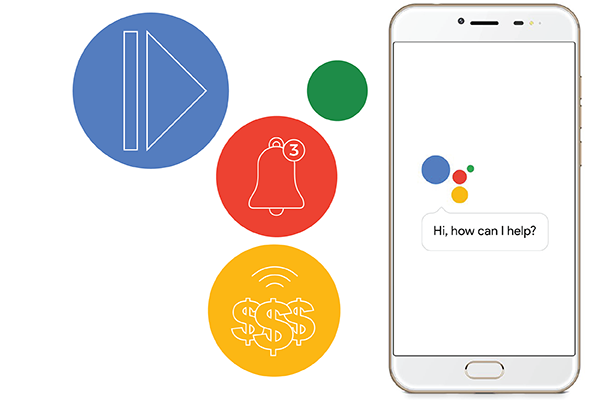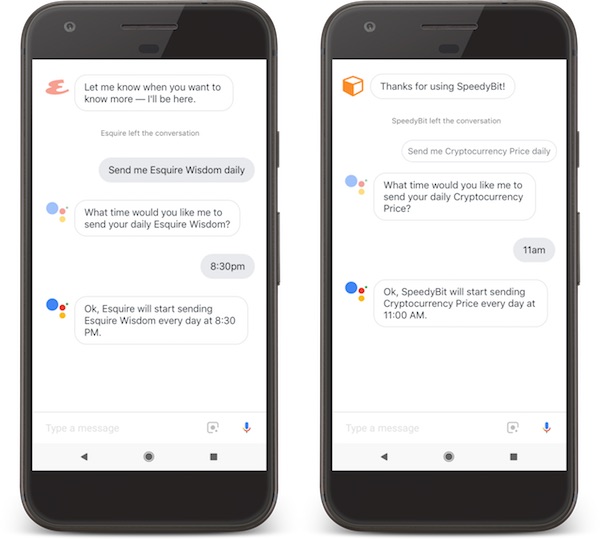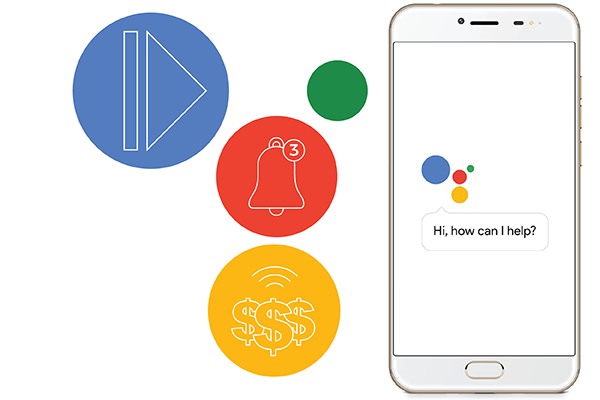Google Assistant Apps Now Support Digital Purchases, Notifications, Media Playback and More

Google Assistant apps now can take advantage of several new features announced today including digital purchases, notifications and media playback. These three features have been among the most requested by developers. The first two deal with common themes around voice app monetization and user retention. The third fills a gap in Google Assistant’s capabilities for delivering third-party media content to users. The updates are already receiving positive reviews by developers. For example, Octavio Menocal, an experienced voice developer from RAIN Agency, summed up his reaction succinctly.

Digital Goods Monetization Through Google Assistant
Monetization on Google Assistant and Amazon Alexa was voted by Voicebot readers as the top story of 2017. There was plenty of focus on driving revenue. However, at the end of the year Google Assistant had only released monetization for physical goods purchasing and Amazon had rolled out digital goods sales for Alexa skills such as games. Google Assistant adds digital goods transactions with this update to the Actions on Google SDK. This provides entirely new monetization and content distribution options for games and media.
The feature could enable a new sale of digital goods or simply make paid content originally purchased though an account in a mobile Android channel available through Google Assistant. Jo Jaquinta is a leading voice app developer, CTO of Tsa Tsa Tzu and creator of Six Swords on Google Assistant. His reaction to the promise of the new digital purchases feature was cautiously positive.
This [access to digital purchases], coupled with Deep Linking to Android announced in February are, by far, the most interesting things. If you are going to go the ‘voice-enabling a mobile app’ route, these are some pretty powerful tools.
The general thinking has been that more third-party developer investment will be poured into voice assistant platforms if there are clear monetization methods. Initially the tools for monetization were absent from the leading services, but the new features represent tangible progress for monetization of media, games and other digital content.
Notifications Are About Re-engagement and Retention
A blog post by Google Assistant group product manager Brad Abrams and product manager Chris Ramsdale highlighted the new features and had this to say about push notifications.
“While having a great user experience is important, we also want to ensure you have the right tools to re-engage your users so they keep coming back to the experience you’ve built…As soon as you submit your Action for review with daily updates or push notifications enabled, and it’s approved, your users will be able to opt into this re-engagement channel.

This feature became available in a closed developer preview a few months back and is currently in use by Esquire, Forbes and SpeedyBit. Notifications have proven to be critical tools for mobile apps to drive user retention. It is unclear about how effective notifications will be for voice assistants because the user interface is very different. However, this initial implementation is specifically for Google Assistant on mobile and not for the Google Home smart speaker so it is more similar to a smartphone implementation than what Amazon Echo is using for notifications with Alexa.
Google Assistant Media Response API
Monetization and notifications are features that can be applied to a wide variety of voice apps whereas the Google Assistant Media Response API is designed to enable entirely new content experiences. The blog post by Abrams and Ramsdale highlighted how this is a major feature enhancement for the platform.
“This past year, we’ve heard from many developers who want to offer great media experiences as part of their Actions. While you can already make your podcasts discoverable to Assistant users, our new media response API allows you to develop deeper, more-engaging audio-focused conversational Actions that include, for example, clips from TV shows, interactive stories, meditation, relaxing sounds, and news briefings.”
Nick Schwab, founder of Invoked Apps and creator of Ambient Sounds on Google Assistant, was quick to point out this feature opens up the opportunity to deliver rich media on the platform. Amazon has had an audio player for Alexa since August 2016. While Google’s implementation is different and in some ways more limited today, it closes a big feature gap for the platform.
Invoked Apps is excited to see media player support come to Actions on Google, allowing us to bring our popular ambient sounds for sleep and relaxation to the platform. Establishing feature parity across voice ecosystems is an important goal for third-party voice developers, so it’s great to see Google taking these efforts seriously on a platform level.
XAPPmedia Chief Product Officer Michael Myers was recruited for early access to the Media Response API and has already implemented podcasts using the new features for the Kirk & Callahan show from Boston’s WEEI radio station and the popular true crime series Sword & Scale. He pointed out that Google Assistant’s implementation could change the way users find and consume media through voice assistants.
The new Media Response API coupled with existing deep link discovery on Google will create new and exciting opportunities for accessing and discovering audio content.
These comments emphasize the two important elements of the new Media Response API. First, it enables developers to make rich media available from streaming sources through their Google Assistant apps. Second, when combined with other Google Assistant features such as deep link discovery, it has the potential to have a significant impact on content discovery.
A New Phase of Google and Amazon Competition
The announcements today combined with several recent feature releases by Amazon signal that we are in a new phase of competition between Google Assistant and Alexa. The first phase focused on having devices available in desirable form factors, at a variety of price points and in a number of languages, while providing some breadth in first-party capabilities. Those first-party capabilities are what the voice assistants can do on their own. The current phase is about enabling third-party voice app developers to create new experience that improve the utility of the platform for users.
Put another way, over the past two years, the primary audience for Google and Amazon has been consumers. This was necessary to persuade more people to purchase the smart speaker devices and try the assistants. Now, the developer audience is becoming more important because of what they can do to increase the value of the platforms for users. Expect to see a lot more action on this front in 2018.
Follow @bretkinsella
Amazon Moves Closer to Enabling Notifications for Alexa Skills









